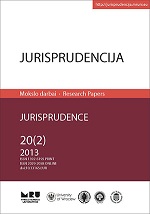Proprietary Complexes: Theoretical Aspects
Proprietary Complexes: Theoretical Aspects
Author(s): Asta Jakutytė-SungailienėSubject(s): Law, Constitution, Jurisprudence
Published by: Mykolas Romeris University
Keywords: object of civil rights; proprietary complex; enterprise; inheritance
Summary/Abstract: In a legal sense, a proprietary complex is comprehended as a totality of the objects of civil rights having common purpose which is referred to as a self-sufficient object having separate monetary value. In contemporary doctrine of private law, wherein the pluralistic theory of civil relationship is prevalent, the object of the civil relationship as well as the object of civil rights is considered the values regarding which of the civil relationship emerged. Proprietary complexes as the multipartite objects of civil rights are comprised of various units of asset. In a legal sense, assets are considered as the objects of civil rights having economic value and capacity to participate in civil turnover, i.e. the owner is able to transfer such object to another person. While forming proprietary complexes, different units of assets (tangible and intangible) are united into a totality which is considered as one object of civil rights. So, if the positive law constitutes a possibility to form proprietary complexes and to participate in civil turnover, it becomes possible to capitalize assets, whereas proprietary complexes are formed in order to gain additional monetary value. Therefore, the purpose of this research is to analyse the formation of proprietary complexes, the genesis and theoretical grounding of proprietary complexes and different kinds of proprietary complexes. The subject matter of the research is the analysis of the concept of proprietary complex, the identification of the features of proprietary complexes and the analysis of particular proprietary complexes. The main methods used in this research are document (content of source), linguistic, systematic and critical analyses as well as historical, comparative and teleological analyses.
Journal: Jurisprudencija
- Issue Year: 20/2013
- Issue No: 2
- Page Range: 513-526
- Page Count: 14
- Language: English

